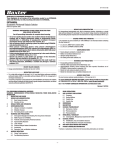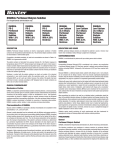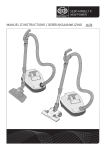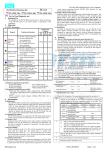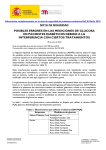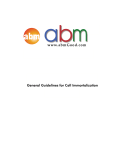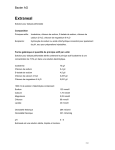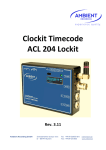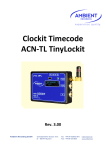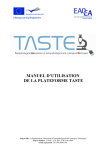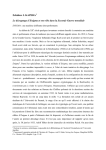Download EXTRANEAL - GlucoseSafety.com
Transcript
Confidential Property of Baxter Healthcare Corporation and its Affiliates Document No.: 07-19-65-351 Change No.: CP0411964 Page 1 of 6 P4 26-Jan-2011 jgg Colors: PMS 287 Blue PROOFREADING INSPECTION / RELEASED ARTWORK Proofreading Approval________________________ ________________________________ Print Name Signature Date Proofreading Approval________________________ ________________________________ Print Name Signature Date 07-19-65-351 EXTRANEAL (icodextrin) Peritoneal Dialysis Solution EXTRANEAL is available for intraperitoneal administration only as a sterile, nonpyrogenic, clear solution in AMBU-FLEX II, AMBU-FLEX III and ULTRABAG containers. The container systems are composed of polyvinyl chloride. Dangerous Drug-Device Interaction Only use glucose-specific monitors and test strips to measure blood glucose levels in patients using EXTRANEAL (icodextrin) Peritoneal Dialysis Solution. Blood glucose monitoring devices using glucose dehydrogenase pyrroloquinolinequinone (GDH-PQQ) or glucose-dye-oxidoreductase (GDO)based methods must not be used. In addition, some blood glucose monitoring systems using glucose dehydrogenase flavin-adenine dinucleotide (GDHFAD)-based methods must not be used. Use of GDH-PQQ, GDO, and GDHFAD-based glucose monitors and test strips has resulted in falsely elevated glucose readings (due to the presence of maltose, see PRECAUTIONS/Drug/ Laboratory Test Interactions). Falsely elevated glucose readings have led patients or health care providers to withhold treatment of hypoglycemia or to administer insulin inappropriately. Both of these situations have resulted in unrecognized hypoglycemia, which has led to loss of consciousness, coma, permanent neurological damage, and death. Plasma levels of EXTRANEAL (icodextrin) and its metabolites return to baseline within approximately 14 days following cessation of EXTRANEAL (icodextrin) administration. Therefore falsely elevated glucose levels may be measured up to two weeks following cessation of EXTRANEAL (icodextrin) therapy when GDH-PQQ, GDO, and GDHFAD-based blood glucose monitors and test strips are used. Solutions in contact with the plastic container can leach out certain of its chemical components in very small amounts within the expiration period, e.g., di-2ethylhexyl phthalate (DEHP), up to 5 parts per million; however, the safety of the plastic has been confirmed in tests in animals according to USP biological tests for plastic containers as well as by tissue culture toxicity studies. CLINICAL PHARMACOLOGY Mechanism of Action EXTRANEAL is an isosmotic peritoneal dialysis solution containing glucose polymers (icodextrin) as the primary osmotic agent. Icodextrin functions as a colloid osmotic agent to achieve ultrafiltration during long peritoneal dialysis dwells. Icodextrin acts in the peritoneal cavity by exerting osmotic pressure across small intercellular pores resulting in transcapillary ultrafiltration throughout the dwell. Like other peritoneal dialysis solutions, EXTRANEAL also contains electrolytes to help normalize electrolyte balance and lactate to help normalize acid-base status. Pharmacokinetics of Icodextrin Absorption Absorption of icodextrin from the peritoneal cavity follows zero-order kinetics consistent with convective transport via peritoneal lymphatic pathways. In a single-dose pharmacokinetic study using EXTRANEAL (icodextrin), a median of 40% (60 g) of the instilled icodextrin was absorbed from the peritoneal solution during a 12-hour dwell. Plasma levels of icodextrin rose during the dwell and declined after the dwell was drained. Peak plasma levels of icodextrin plus its metabolites (median Cpeak 2.2g/L) were observed at the end of the long dwell exchange (median Tmax = 13 hours). At steady-state, the mean plasma level of icodextrin plus its metabolites was about 5 g/L. In multidose studies, steady-state levels of icodextrin were achieved within one week. Plasma levels of icodextrin and metabolites return to baseline values within approximately two weeks following cessation of icodextrin administration. Metabolism Icodextrin is metabolized by alpha-amylase into oligosaccharides with a lower degree of polymerization (DP), including maltose (DP2), maltotriose (DP3), maltotetraose (DP4), and higher molecular weight species. In a single dose study, DP2, DP3 and DP4 showed a progressive rise in plasma concentrations with a profile similar to that for total icodextrin, with peak values reached by the end of the dwell and declining thereafter. Only very small increases in blood levels of larger polymers were observed. Steady-state plasma levels of icodextrin metabolites were achieved within one week and stable plasma levels were observed during long-term administration. Some degree of metabolism of icodextrin occurs intraperitoneally with a progressive rise in the concentration of the smaller polymers in the dialysate during the 12-hour dwell. Elimination Icodextrin undergoes renal elimination in direct proportion to the level of residual renal function. Diffusion of the smaller icodextrin metabolites from plasma into the peritoneal cavity is also possible after systemic absorption and metabolism of icodextrin. Special Populations Geriatrics The influence of age on the pharmacokinetics of icodextrin and its metabolites was not assessed. Gender and Race The influence of gender and race on the pharmacokinetics of icodextrin and its metabolites was not assessed. Clinical Studies EXTRANEAL has demonstrated efficacy as a peritoneal dialysis solution in clinical trials of approximately 480 patients studied with end-stage renal disease (ESRD). Ultrafiltration, Urea and Creatinine Clearance In the active-controlled trials of one to six months in duration, described below, EXTRANEAL used once-daily for the long dwell in either continuous ambulatory peritoneal dialysis (CAPD) or automated peritoneal dialysis (APD) therapy resulted in higher net ultrafiltration than 1.5% and 2.5% dextrose solutions, and higher creatinine and urea nitrogen clearances than 2.5% dextrose. Net ultrafiltration was similar to 4.25% dextrose across all patients in these studies. Effects were generally similar in CAPD and APD. Because GDH-PQQ, GDO, and GDH-FAD-based blood glucose monitors may be used in hospital settings, it is important that the health care providers of peritoneal dialysis patients using EXTRANEAL (icodextrin) carefully review the product information of the blood glucose testing system, including that of test strips, to determine if the system is appropriate for use with EXTRANEAL (icodextrin). To avoid improper insulin administration, educate patients to alert health care providers of this interaction whenever they are admitted to the hospital. The manufacturer(s) of the monitor and test strips should be contacted to determine if icodextrin or maltose causes interference or falsely elevated glucose readings. For a list of toll free numbers for glucose monitor and test strip manufacturers, please contact the Baxter Renal Clinical Help Line 1-888-RENAL-HELP or visit www.glucosesafety.com. DESCRIPTION EXTRANEAL (icodextrin) Peritoneal Dialysis Solution is a peritoneal dialysis solution containing the colloid osmotic agent icodextrin. Icodextrin is a starchderived, water-soluble glucose polymer linked by alpha (1-4) and less than 10% alpha (1-6) glucosidic bonds with a weight-average molecular weight between 13,000 and 19,000 Daltons and a number average molecular weight between 5,000 and 6,500 Daltons. The representative structural formula of icodextrin is: Each 100 mL of EXTRANEAL contains: Icodextrin 7.5 g Sodium Chloride, USP 535 mg Sodium Lactate 448 mg Calcium Chloride, USP 25.7 mg Magnesium Chloride, USP 5.08 mg Electrolyte content per liter: Sodium 132 mEq/L Calcium 3.5 mEq/L Magnesium 0.5 mEq/L Chloride 96 mEq/L Lactate 40 mEq/L Water for Injection, USP qs HCl/NaOH may have been used to adjust pH. EXTRANEAL contains no bacteriostatic or antimicrobial agents. Calculated osmolarity: 282–286 mOsm/L; pH=5.0-6.0 -1- Confidential Property of Baxter Healthcare Corporation and its Affiliates Document No.: 07-19-65-351 Change No.: CP0411964 Page 2 of 6 P5 21-Mar-2011 jgg Colors: PMS 287 Blue PROOFREADING INSPECTION / RELEASED ARTWORK Proofreading Approval________________________ ________________________________ Print Name Signature Date Proofreading Approval________________________ ________________________________ Print Name Signature Date 07-19-65-351 Figure 3 – Mean Net Ultrafiltration, Creatinine and Urea Nitrogen Clearances and Ultrafiltration Efficiency for the Long Dwell in High Average/High Transporter Patients In an additional randomized, multicenter, active-controlled two-week study in high average/high transporter APD patients, EXTRANEAL used once daily for the long dwell produced higher net ultrafiltration compared to 4.25% dextrose. Mean creatinine and urea nitrogen clearances were also greater with EXTRANEAL and ultrafiltration efficiency was improved. In 175 CAPD patients randomized to EXTRANEAL (N=90) or 2.5% dextrose solution (N=85) for the 8-15 hour overnight dwell for one month, mean net ultrafiltration for the overnight dwell was significantly greater in the EXTRANEAL group at weeks 2 and 4 (Figure 1). Mean creatinine and urea nitrogen clearances were also greater with EXTRANEAL (Figure 2). Figure 1 - Mean Net Ultrafiltration for the Overnight Dwell *p<0.001 EXTRANEAL vs. 2.5% dextrose (adjusted for baseline) *p<0.001 EXTRANEAL vs. 4.25% dextrose (adjusted for baseline) *p<0.001 EXTRANEAL vs. 4.25% dextrose (adjusted for baseline) *p<0.001 EXTRANEAL vs. 4.25% dextrose (adjusted for baseline) Peritoneal Membrane Transport Characteristics: After one year of treatment with EXTRANEAL during the long dwell exchange, there were no differences in membrane transport characteristics for urea and creatinine. The mass transfer area coefficients (MTAC) for urea, creatinine, and glucose at one year were not different in patients receiving treatment with EXTRANEAL or 2.5% dextrose solution for the long dwell. INDICATIONS AND USAGE EXTRANEAL is indicated for a single daily exchange for the long (8- to 16- hour) dwell during continuous ambulatory peritoneal dialysis (CAPD) or automated peritoneal dialysis (APD) for the management of end-stage renal disease. EXTRANEAL is also indicated to improve (compared to 4.25% dextrose) longdwell ultrafiltration and clearance of creatinine and urea nitrogen in patients with high average or greater transport characteristics, as defined using the peritoneal equilibration test (PET). (See CLINICAL PHARMACOLOGY, Clinical Studies) Figure 2 - Mean Creatinine and Urea Nitrogen Clearance for the Overnight Dwell *p<0.001 EXTRANEAL vs. 2.5% dextrose (adjusted for baseline) *p<0.001 EXTRANEAL vs. 4.25% dextrose (adjusted for baseline) *p<0.001 EXTRANEAL vs. 2.5% dextrose (adjusted for baseline) In another study of 39 APD patients randomized to EXTRANEAL or 2.5% dextrose solution for the long, daytime dwell (10-17 hours) for three months, the net ultrafiltration reported during the treatment period was (mean ± SD) 278 ± 192 mL for the EXTRANEAL group and –138 ± 352 mL for the dextrose group (p<0.001). Mean creatinine and urea nitrogen clearances were significantly greater for EXTRANEAL than 2.5% dextrose at weeks 6 and 12 (p<0.001). In a six-month study in CAPD patients comparing EXTRANEAL (n=28) with 4.25% dextrose (n=31), net ultrafiltration achieved during an 8-hour dwell averaged 510 mL for EXTRANEAL and 556 mL for 4.25% dextrose. For 12-hour dwells, net ultrafiltration averaged 575 mL for EXTRANEAL (n=29) and 476 mL for 4.25% dextrose (n=31). There was no significant difference between the two groups with respect to ultrafiltration. In a two week study in high average/high transporter APD patients (4-hour D/P creatinine ratio >0.70 and a 4-hour D/D0 ratio <0.34, as defined by the peritoneal equilibration test (PET)), comparing EXTRANEAL (n=47) to 4.25% dextrose (n=45), after adjusting for baseline, the mean net ultrafiltration achieved during a 14 ± 2 hour dwell was significantly greater in the EXTRANEAL group than the 4.25% dextrose group at weeks 1 and 2 (p<0.001, see Figure 3). Consistent with increases in net ultrafiltration, there were also significantly greater creatinine and urea nitrogen clearances and ultrafiltration efficiency in the EXTRANEAL group (p<0.001, see Figure 3). -2- CONTRAINDICATIONS EXTRANEAL (icodextrin) is contraindicated in patients with a known allergy to cornstarch or icodextrin, in patients with maltose or isomaltose intolerance, in patients with glycogen storage disease, and in patients with pre-existing severe lactic acidosis. WARNINGS Dangerous Drug-Device Interaction (See BOXED WARNING) Only use glucose-specific monitors and test strips to measure blood glucose levels in patients using EXTRANEAL (icodextrin) Peritoneal Dialysis Solution. Blood glucose monitoring devices using glucose dehydrogenase pyrroloquinolinequinone (GDH-PQQ) or glucose-dye-oxidoreductase (GDO)-based methods must not be used. In addition, some blood glucose monitoring systems using glucose dehydrogenase flavin-adenine dinucleotide (GDH-FAD)-based methods must not be used. Use of GDH-PQQ, GDO, and GDH-FAD-based glucose monitors and test strips has resulted in falsely elevated glucose readings (due to the presence of maltose, see PRECAUTIONS/Drug/Laboratory Test Interactions). Falsely elevated glucose readings have led patients or health care providers to withhold treatment of hypoglycemia or to administer insulin inappropriately. Both of these situations have resulted in unrecognized hypoglycemia, which has led to loss of consciousness, coma, permanent neurological damage, and death. Plasma levels of EXTRANEAL (icodextrin) and its metabolites return to baseline within approximately 14 days following cessation of EXTRANEAL (icodextrin) administration. Therefore falsely elevated glucose levels may be measured up to two weeks following cessation of EXTRANEAL (icodextrin) therapy when GDHPQQ, GDO, and GDH-FAD-based blood glucose monitors and test strips are used. Because GDH-PQQ, GDO, and GDH-FAD-based blood glucose monitors may be used in hospital settings, it is important that the health care providers of peritoneal dialysis patients using EXTRANEAL (icodextrin) carefully review the product information of the blood glucose testing system, including that of test strips, to determine if the system is appropriate for use with EXTRANEAL (icodextrin). To avoid improper insulin administration, educate patients to alert health care providers of this interaction whenever they are admitted to the hospital. Confidential Property of Baxter Healthcare Corporation and its Affiliates Document No.: 07-19-65-351 Change No.: CP0411964 Page 3 of 6 P3 21-Jan-2011 jgg Colors: PMS 287 Blue PROOFREADING INSPECTION / RELEASED ARTWORK Proofreading Approval________________________ ________________________________ Print Name Signature Date Proofreading Approval________________________ ________________________________ Print Name Signature Date 07-19-65-351 The manufacturer(s) of the monitor and test strips should be contacted to determine if icodextrin or maltose causes interference or falsely elevated glucose readings. For a list of toll free numbers for glucose monitor and test strip manufacturers, please contact the Baxter Renal Clinical Help Line 1-888-RENALHELP or visit www.glucosesafety.com. Insulin-dependent diabetes mellitus Patients with insulin-dependent diabetes may require modification of insulin dosage following initiation of treatment with EXTRANEAL. Appropriate monitoring of blood glucose should be performed and insulin dosage adjusted if needed (See WARNINGS; PRECAUTIONS, Drug/Laboratory Test Interactions). EXTRANEAL is intended for intraperitoneal administration only. Not for intravenous injection. Encapsulating peritoneal sclerosis (EPS) is a known, rare complication of peritoneal dialysis therapy. EPS has been reported in patients using peritoneal dialysis solutions including EXTRANEAL(icodextrin). Infrequent but fatal outcomes have been reported. If peritonitis occurs, the choice and dosage of antibiotics should be based upon the results of identification and sensitivity studies of the isolated organism(s) when possible. Prior to the identification of the involved organism(s), broadspectrum antibiotics may be indicated. Rarely, serious hypersensitivity reactions to EXTRANEAL have been reported such as toxic epidermal necrolysis, angioedema, serum sickness, erythema multiforme and leukocytoclastic vasculitis. If a serious reaction is suspected, discontinue EXTRANEAL and institute appropriate treatment as clinically indicated. Patients with severe lactic acidosis should not be treated with lactate-based peritoneal dialysis solutions (See CONTRAINDICATIONS). It is recommended that patients with conditions known to increase the risk of lactic acidosis [e.g., acute renal failure, inborn errors of metabolism, treatment with drugs such as metformin and nucleoside/nucleotide reverse transcriptase inhibitors (NRTIs)] must be monitored for occurrence of lactic acidosis before the start of treatment and during treatment with lactate-based peritoneal dialysis solutions. When prescribing the solution to be used for an individual patient, consideration should be given to the potential interaction between the dialysis treatment and therapy directed at other existing illnesses. Serum potassium levels should be monitored carefully in patients treated with cardiac glycosides. For example, rapid potassium removal may create arrhythmias in cardiac patients using digitalis or similar drugs; digitalis toxicity may be masked by hyperkalemia, hypermagnesemia, or hypocalcemia. Correction of electrolytes by dialysis may precipitate signs and symptoms of digitalis excess. Conversely, toxicity may occur at suboptimal dosages of digitalis if potassium is low or calcium high. Information for Patients. Patients should be instructed not to use solutions if they are cloudy, discolored, contain visible particulate matter, or if they show evidence of leaking containers. Aseptic technique should be employed throughout the procedure. To reduce possible discomfort during administration, patients should be instructed that solutions may be warmed to 37°C (98°F) prior to use. Only dry heat should be used. It is best to warm solutions within the overwrap using a heating pad. To avoid contamination, solutions should not be immersed in water for warming. Do not use a microwave oven to warm EXTRANEAL. Heating the solution above 40°C (104°F) may be detrimental to the solution. (See DOSAGE AND ADMINISTRATION, Directions for Use). Because the use of EXTRANEAL interferes with glucose dehydrogenase pyrroloquinolinequinone (GDH-PQQ), glucose-dye-oxidoreductase (GDO), and some GDH-FAD-based blood glucose measurements, patients must be instructed to use only glucose-specific glucose monitors and test strips. (See WARNINGS; PRECAUTIONS, Drug/Laboratory Test Interactions). A Patient Medication Guide is provided in each carton of EXTRANEAL. PRECAUTIONS General Peritoneal Dialysis-Related The following conditions may predispose to adverse reactions to peritoneal dialysis procedures: abdominal conditions, including uncorrectable mechanical defects that prevent effective PD or increase the risk of infection, disruption of the peritoneal membrane and diaphragm by surgery, congenital anomalies or trauma prior to complete healing, abdominal tumors, abdominal wall infections, hernias, fecal fistula, colostomies or ileostomies, frequent episodes of diverticulitis, inflammatory or ischemic bowel disease, large polycystic kidneys, or other conditions that compromise the integrity of the abdominal wall, abdominal surface, or intra-abdominal cavity, such as documented loss of peritoneal function or extensive adhesions that compromise peritoneal function. Conditions that preclude normal nutrition, impaired respiratory function, recent aortic graft placement, and potassium deficiency may also predispose to complications of peritoneal dialysis. Aseptic technique should be employed throughout the peritoneal dialysis procedure to reduce the possibility of infection. Following use, the drained fluid should be inspected for the presence of fibrin or cloudiness, which may indicate the presence of peritonitis. Overinfusion of peritoneal dialysis solution volume into the peritoneal cavity may be characterized by abdominal distention, feeling of fullness and/or shortness of breath. Treatment of overinfusion is to drain the peritoneal dialysis solution from the peritoneal cavity. Laboratory Tests Serum Electrolytes Decreases in serum sodium and chloride have been observed in patients using EXTRANEAL. The mean change in serum sodium from baseline to the last study visit was –2.8 mmol/L for patients on EXTRANEAL and –0.3 mmol/L for patients on control solution. Four EXTRANEAL patients and two control patients developed serum sodium < 125 mmol/L. The mean change in serum chloride from baseline to last study visit was –2.0 mmol/L for EXTRANEAL patients and + 0.6 mmol/L for control patients. Similar changes in serum chemistries were observed in an additional clinical study in a subpopulation of high average/high transporter patients. The declines in serum sodium and chloride may be related to dilution resulting from the presence of icodextrin metabolites in plasma. Although these decreases have been small and clinically unimportant, monitoring of the patients’ serum electrolyte levels as part of routine blood chemistry testing is recommended. EXTRANEAL does not contain potassium. Evaluate serum potassium prior to administering potassium chloride to the patient. In situations where there is a normal serum potassium level or hypokalemia, addition of potassium chloride (up to a concentration of 4 mEq/L) to the solution may be necessary to prevent severe hypokalemia. This should be made under careful evaluation of serum and total body potassium, and only under the direction of a physician. Fluid, hematology, blood chemistry, electrolyte concentrations, and bicarbonate should be monitored periodically. If serum magnesium levels are low, magnesium supplements may be used. Alkaline Phosphatase An increase in mean serum alkaline phosphatase has been observed in clinical studies of ESRD patients receiving EXTRANEAL. No associated increases in liver function tests were observed. Serum alkaline phosphatase levels did not show evidence of progressive increase over a 12-month study period. Levels returned to normal approximately two weeks after discontinuation of EXTRANEAL. There were individual cases where increased alkaline phosphatase was associated with elevated AST (SGOT), but neither elevation was considered causally related to treatment. Need for Trained Physician Treatment should be initiated and monitored under the supervision of a physician knowledgeable in the management of patients with renal failure. A patient’s volume status should be carefully monitored to avoid hyper- or hypovolemia and potentially severe consequences including congestive heart failure, volume depletion and hypovolemic shock. An accurate fluid balance record must be kept and the patient’s body weight monitored. Significant losses of protein, amino acids, water-soluble vitamins and other medicines may occur during peritoneal dialysis. The patient’s nutritional status should be monitored and replacement therapy should be provided as necessary. In patients with hypercalcemia, particularly in those on low-calcium peritoneal dialysis solutions, consideration should be given to the fact that EXTRANEAL is not provided in a low-calcium electrolyte solution. Solutions that are cloudy, contain particulate matter, or show evidence of leakage should not be used. -3- Drug Interactions General No clinical drug interaction studies were performed. No evaluation of EXTRANEAL’s effects on the cytochrome P450 system was conducted. As with other dialysis solutions, blood concentrations of dialyzable drugs may be reduced by dialysis. Dosage adjustment of concomitant medications may be necessary. In patients using cardiac glycosides (digoxin and others), plasma levels of calcium, potassium and magnesium must be carefully monitored. Insulin A clinical study in 6 insulin-dependent diabetic patients demonstrated no effect of EXTRANEAL on insulin absorption from the peritoneal cavity or on insulin’s ability to control blood glucose when insulin was administered intraperitoneally with EXTRANEAL. However, appropriate monitoring (See PRECAUTIONS, Drug/ Laboratory Test Interactions) of blood glucose should be performed when initiating EXTRANEAL in diabetic patients and insulin dosage should be adjusted if needed (See PRECAUTIONS). Confidential Property of Baxter Healthcare Corporation and its Affiliates Document No.: 07-19-65-351 Change No.: CP0411964 Page 4 of 6 P3 21-Jan-2011 jgg Colors: PMS 287 Blue PROOFREADING INSPECTION / RELEASED ARTWORK Proofreading Approval________________________ ________________________________ Print Name Signature Date Proofreading Approval________________________ ________________________________ Print Name Signature Date 07-19-65-351 Heparin No human drug interaction studies with heparin were conducted. In vitro studies demonstrated no evidence of incompatibility of heparin with EXTRANEAL. ADVERSE REACTIONS Clinical Trials Because clinical trials are conducted under widely varying conditions, adverse reaction rates observed in clinical trials of a drug cannot be compared to rates in the clinical trials of another drug and may not reflect the rates observed in practice. The adverse reaction information from clinical trials does, however, provide a basis for identifying the adverse events that appear to be related to drug use and for approximating rates. Antibiotics No human drug interaction studies with antibiotics were conducted. In vitro studies evaluating the minimum inhibitory concentration (MIC) of vancomycin, cefazolin, ampicillin, ampicillin/flucoxacillin, ceftazidime, gentamicin, and amphotericin demonstrated no evidence of incompatibility of these antibiotics with EXTRANEAL. (See DOSAGE AND ADMINISTRATION) Drug/Laboratory Test Interactions Blood Glucose Blood glucose measurement must be done with a glucose-specific method to prevent maltose interference with test results. Falsely elevated glucose levels have been observed with blood glucose monitoring devices and test strips that use glucose dehydrogenase pyrroloquinolinequinone (GDH-PQQ), glucosedye-oxidoreductase (GDO), and some glucose dehydrogenase flavin-adenine nucleotide (GDH-FAD)-based methods. GDH-PQQ,glucose-dye-oxidoreductase, and some GDH-FAD-based methods must not be used to measure glucose levels in patients administered EXTRANEAL. (See WARNINGS). Serum Amylase An apparent decrease in serum amylase activity has been observed in patients administered EXTRANEAL. Preliminary investigations indicate that icodextrin and its metabolites interfere with enzymatic-based amylase assays, resulting in inaccurately low values. This should be taken into account when evaluating serum amylase levels for diagnosis or monitoring of pancreatitis in patients using EXTRANEAL. EXTRANEAL was originally studied in controlled clinical trials of 493 patients with end-stage renal disease who received a single daily exchange of EXTRANEAL for the long dwell (8-to 16- hours). There were 215 patients exposed for at least 6 months and 155 patients exposed for at least one year. The population was 18-83 years of age, 56% male and 44% female, 73% Caucasian, 18% Black, 4% Asian, 3% Hispanic, and it included patients with the following comorbid conditions: 27% diabetes, 49% hypertension and 23% hypertensive nephropathy. Rash was the most frequently occurring EXTRANEAL-related adverse event (5.5%, EXTRANEAL; 1.7% Control). Seven patients on EXTRANEAL discontinued treatment due to rash, and one patient on EXTRANEAL discontinued due to exfoliative dermatitis. The rash typically appeared within the first three weeks of treatment and resolved with treatment discontinuation or, in some patients, with continued treatment. Female patients reported a higher incidence of skin events, including rash, in both EXTRANEAL and dextrose control treatment groups. Carcinogenesis, Mutagenesis, Impairment of Fertility Icodextrin did not demonstrate evidence of genotoxicity potential in in vitro bacterial cell reverse mutation assay (Ames test); in vitro mammalian cell chromosomal aberration assay (CHO cell assay); and in the in vivo micronucleus assay in rats. Long-term animal studies to evaluate the carcinogenic potential of EXTRANEAL or icodextrin have not been conducted. Icodextrin is derived from maltodextrin, a common food ingredient. A fertility study in rats where males and females were treated for four and two weeks, respectively, prior to mating and until day 17 of gestation at up to 1.5 g/kg/day (1/3 the human exposure on a mg/m2 basis) revealed slightly low epididymal weights in parental males in the high dose group as compared to Control. Toxicological significance of this finding was not evident as no other reproductive organs were affected and all males were of proven fertility. The study demonstrated no effects of treatment with icodextrin on mating performance, fertility, litter response, embryo-fetal survival, or fetal growth and development. Pregnancy Pregnancy Category C Complete animal reproduction studies including in utero embryofetal development at appreciable multiples of human exposure have not been conducted with EXTRANEAL or icodextrin. Thus it is not known whether icodextrin or EXTRANEAL solution can cause fetal harm when administered to a pregnant woman or affect reproductive capacity. EXTRANEAL should only be utilized in pregnant women when the need outweighs the potential risks. Nursing Mothers It is not known whether icodextrin or its metabolites are excreted in human milk. Because many drugs are excreted in human milk, caution should be exercised when EXTRANEAL is administered to a nursing woman. Table 1 shows the adverse events reported in these clinical studies, regardless of causality, occurring in ≥ 5% of patients and more common on EXTRANEAL than control. Adverse reactions reported with an incidence of > 5% and at least as common on dextrose control included pain, asthenia, exit site infection, infection, back pain, hypotension, diarrhea, vomiting, nausea/vomiting, anemia, peripheral edema, hypokalemia, hyperphosphatemia, hypoproteinemia, hypervolemia, arthralgia, dizziness, dyspnea, skin disorder, pruritis. Additional adverse events occurring at an incidence of < 5% and that may or may not have been related to EXTRANEAL include: pain on infusion, abdominal enlargement, cloudy effluent, ultrafiltration decrease, postural hypotension, heart failure, hyponatremia, hypochloremia, hypercalcemia, hypoglycemia, alkaline phosphatase increase, SGPT increase, SGOT increase, cramping, confusion, lung edema, facial edema, exfoliative dermatitis, eczema, vesicobullous rash, maculopapular rash, erythema multiforme. All reported events are included in the list except those already listed in Table 1 or the following two paragraphs, those not plausibly associated with EXTRANEAL, and those that were associated with the condition being treated or related to the dialysis procedure. Pediatric Use Safety and effectiveness in pediatric patients have not been established. Geriatric Use No formal studies were specifically carried out in the geriatric population. However, 140 of the patients in clinical studies of EXTRANEAL were age 65 or older, with 28 of the patients age 75 or older. No overall differences in safety or effectiveness were observed between these patients and patients under age 65. Although clinical experience has not identified differences in responses between the elderly and younger patients, greater sensitivity of some older individuals cannot be ruled out. EXTRANEAL was additionally studied in a subpopulation of 92 high average/high transporter APD patients in a two-week controlled clinical trial where patients received a single daily exchange of EXTRANEAL (n=47) or dextrose control (n=45) for the long dwell (14 ± 2 hours). Consistent with the data reported in the original trials of EXTRANEAL, rash was the most frequently occurring event. -4- Confidential Property of Baxter Healthcare Corporation and its Affiliates Document No.: 07-19-65-351 Change No.: CP0411964 Page 5 of 6 P3 21-Jan-2011 jgg Colors: PMS 287 Blue PROOFREADING INSPECTION / RELEASED ARTWORK Proofreading Approval________________________ ________________________________ Print Name Signature Date Proofreading Approval________________________ ________________________________ Print Name Signature Date 07-19-65-351 DOSAGE AND ADMINISTRATION EXTRANEAL is intended for intraperitoneal administration only. It should be administered only as a single daily exchange for the long dwell in continuous ambulatory peritoneal dialysis or automated peritoneal dialysis. The recommended dwell time is 8- to 16- hours. Not for intravenous injection. Patients should be carefully monitored to avoid under- or over-hydration. An accurate fluid balance record must be kept and the patient’s body weight monitored to avoid potentially severe consequences including congestive heart failure, volume depletion, and hypovolemic shock. Aseptic technique should be used throughout the peritoneal dialysis procedure. To reduce possible discomfort during administration, solutions may be warmed prior to use. (See DOSAGE AND ADMINISTRATION, Directions for Use). EXTRANEAL should be administered over a period of 10-20 minutes at a rate that is comfortable for the patient. Do not use EXTRANEAL if it is cloudy or discolored, if it contains particulate matter, or if the container is leaky. Following use, the drained fluid should be inspected for the presence of fibrin or cloudiness, which may indicate the presence of peritonitis. For single use only. Discard unused portion. Peritoneal Dialysis-Related Adverse events common to the peritoneal dialysis, including peritonitis, infection around the catheter, fluid and electrolyte imbalance, and pain, were observed at a similar frequency with EXTRANEAL and Controls (See PRECAUTIONS). Changes in Alkaline Phosphatase and Serum Electrolytes An increase in mean serum alkaline phosphatase has been observed in clinical studies of ESRD patients receiving EXTRANEAL. No associated increases in other liver chemistry tests were observed. Serum alkaline phosphatase levels did not show progressive increase over a 12-month study period. Levels returned to normal approximately two weeks after discontinuation of EXTRANEAL. Decreases in serum sodium and chloride have been observed in patients using EXTRANEAL. The declines in serum sodium and chloride may be related to dilution resulting from the presence of icodextrin metabolites in plasma. Although these decreases have been small and clinically unimportant, monitoring of patients’ serum electrolyte levels as part of routine blood chemistry testing is recommended. Post-Marketing The following adverse reactions have been identified during post-approval use of EXTRANEAL. Because these reactions are reported voluntarily from a population of uncertain size, it is not possible to estimate their frequency reliably or to establish a causal relationship to drug exposure. Adverse reactions are listed by MedDRA System Order Class (SOC), followed by Preferred Term in order of severity. Addition of Potassium Potassium is omitted from EXTRANEAL solutions because dialysis may be performed to correct hyperkalemia. In situations where there is a normal serum potassium level or hypokalemia, the addition of potassium chloride (up to a concentration of 4 mEq/L) may be indicated to prevent severe hypokalemia. The decision to add potassium chloride should be made by the physician after careful evaluation of serum potassium. INFECTIONS AND INFESTATIONS: Fungal peritonitis, Peritonitis bacterial, Catheter site infection, Catheter related infection BLOOD AND LYMPHATIC SYSTEM DISORDERS: Thrombocytopenia, Leukopenia IMMUNE SYSTEM DISORDERS: Leukocytoclastic vasculitis, Serum sickness, Hypersensitivity METABOLISM AND NUTRITION DISORDERS: Shock hypoglycemia, Fluid overload, Dehydration, Fluid imbalance NERVOUS SYSTEM DISORDERS: Hypoglycemic coma, Burning sensation EYE DISORDERS: Vision blurred RESPIRATORY, THORACIC, AND MEDIASTINAL DISORDERS: Bronchospasm, Stridor GASTROINTESTINAL DISORDERS: Sclerosing encapsulating peritonitis, Aseptic peritonitis, Peritoneal cloudy effluent, Ileus, Ascites, Inguinal hernia, Abdominal discomfort SKIN AND SUBCUTANEOUS DISORDERS: Toxic epidermal necrolysis, Erythema multiforme, Angioedema, Urticaria generalized, Toxic skin eruption, Swelling face, Periorbital edema, Exfoliative rash, Skin exfoliation, Prurigo, Rash (including macular, papular, erythematous, exfoliative), Dermatitis (including allergic and contact), Drug eruption, Erythema, Onychomadesis, Dry skin, Skin chapped, Blister MUSCULOSKELETAL, CONNECTIVE TISSUE DISORDERS: Arthralgia, Back pain, Musculoskeletal pain REPRODUCTIVE SYSTEM AND BREAST DISORDERS: Penile edema, Scrotal edema GENERAL DISORDERS AND ADMINISTRATIVE SITE CONDITIONS: Discomfort, Pyrexia, Chills, Malaise, Drug effect decreased, Drug ineffective, Catheter site erythema, Catheter site inflammation, Infusion related reaction (including Infusion site pain, Instillation site pain) Addition of Insulin Addition of insulin to EXTRANEAL was evaluated in 6 insulin-dependent diabetic patients undergoing CAPD for end stage renal disease. No interference of EXTRANEAL with insulin absorption from the peritoneal cavity or with insulin’s ability to control blood glucose was observed. (See PRECAUTIONS, Drug/ Laboratory Test Interactions). Appropriate monitoring of blood glucose should be performed when initiating EXTRANEAL in diabetic patients and insulin dosage adjusted if needed (See PRECAUTIONS). Addition of Heparin No human drug interaction studies with heparin were conducted. In vitro studies demonstrated no evidence of incompatibility of heparin with EXTRANEAL. Addition of Antibiotics No formal clinical drug interaction studies have been performed. In vitro compatibility studies with EXTRANEAL (icodextrin) and the following antibiotics have demonstrated no effects with regard to minimum inhibitory concentration (MIC): vancomycin, cefazolin, ampicillin, ampicillin/flucoxacillin, ceftazidime, gentamicin, and amphotericin. However, aminoglycosides should not be mixed with penicillins due to chemical incompatibility. Patients undergoing peritoneal dialysis should be under careful supervision of a physician experienced in the treatment of end-stage renal disease with peritoneal dialysis. It is recommended that patients being placed on peritoneal dialysis should be appropriately trained in a program that is under supervision of a physician. DRUG ABUSE AND DEPENDENCE There has been no observed potential of drug abuse or dependence with EXTRANEAL. OVERDOSAGE No data are available on experiences of overdosage with EXTRANEAL. Overdosage of EXTRANEAL would be expected to result in higher levels of serum icodextrin and metabolites, but it is not known what signs or symptoms might be caused by exposure in excess of the exposures used in clinical trials. In the event of overdosage with EXTRANEAL, continued peritoneal dialysis with glucose-based solutions should be provided. -5- Confidential Property of Baxter Healthcare Corporation and its Affiliates Document No.: 07-19-65-351 Change No.: CP0411964 Page 6 of 6 P4 26-Jan-2011 jgg Colors: PMS 287 Blue PROOFREADING INSPECTION / RELEASED ARTWORK Proofreading Approval________________________ ________________________________ Print Name Signature Date Proofreading Approval________________________ ________________________________ Print Name Signature Date 07-19-65-351 Directions for Use For complete CAPD and APD system preparation, see directions accompanying ancillary equipment. Aseptic technique should be used. Warming For patient comfort, EXTRANEAL can be warmed to 37°C (98°F). Only dry heat should be used. It is best to warm solutions within the overwrap using a heating pad. Do not immerse EXTRANEAL in water for warming. Do not use a microwave oven to warm EXTRANEAL. Heating above 40°C (104°F) may be detrimental to the solution. To Open To open, tear the overwrap down at the slit and remove the solution container. Some opacity of the plastic, due to moisture absorption during the sterilization process, may be observed. This does not affect the solution quality or safety and may often leave a slight amount of moisture within the overwrap. Inspect for Container Integrity Inspect the container for signs of leakage and check for minute leaks by squeezing the container firmly. Adding Medications Some drug additives may be incompatible with EXTRANEAL. See DOSAGE AND ADMINISTRATION section for additional information. If the re-sealable rubber plug on the medication port is missing or partly removed, do not use the product if medication is to be added. HOW SUPPLIED EXTRANEAL (icodextrin) Peritoneal Dialysis Solution is available in the following containers and fill volumes: Container ULTRABAG ULTRABAG ULTRABAG AMBU-FLEX III AMBU-FLEX III AMBU-FLEX III AMBU-FLEX II AMBU-FLEX II Fill Volume 1.5 L 2.0 L 2.5 L 1.5 L 2.0 L 2.5 L 2.0 L 2.5 L NDC NDC 0941-0679-51 NDC 0941-0679-52 NDC 0941-0679-53 NDC 0941-0679-45 NDC 0941-0679-47 NDC 0941-0679-48 NDC 0941-0679-06 NDC 0941-0679-05 Each 100 mL of EXTRANEAL contains 7.5 grams of icodextrin in an electrolyte solution with 40 mEq/L lactate. Store at 20–25°C (68–77°F). Excursions permitted to 15–30°C (59–86°F) [See USP Controlled Room Temperature]. Store in moisture barrier overwrap in carton until ready to use. Protect from freezing. Rx Only 1. Put on mask. Clean and/or disinfect hands. 2. Prepare medication port site using aseptic technique. 3. Using a syringe with a 1-inch long, 25- to 19-gauge needle, puncture the medication port and inject additive. 4. Reposition container with container ports up and evacuate medication port by squeezing and tapping it. 5. Mix solution and additive thoroughly. Preparation for Administration 1. Put on mask. Clean and/or disinfect hands. 2. Place EXTRANEAL on work surface. 3. Remove pull ring from connector of solution container. If continuous fluid flow from connector is observed, discard solution container. 4. Remove tip protector from tubing set and immediately attach to connector of solution container. 5. Continue with therapy set-up as instructed in user manual or directions accompanying tubing sets. 6. Upon completion of therapy, discard any unused portion. Baxter, Extraneal, UltraBag, and Ambu-Flex are trademarks of Baxter International Inc. Baxter Healthcare Corporation Deerfield, IL 60015 USA Printed in USA 07-19-65-351 2010/10 *BAR CODE POSITION ONLY 071965351 -6- *This artwork requires the plant to print a bar code(s) per specification. Bar code human readable information must match human readable on spec. Bar code(s) must conform to all applicable Baxter specifications.






